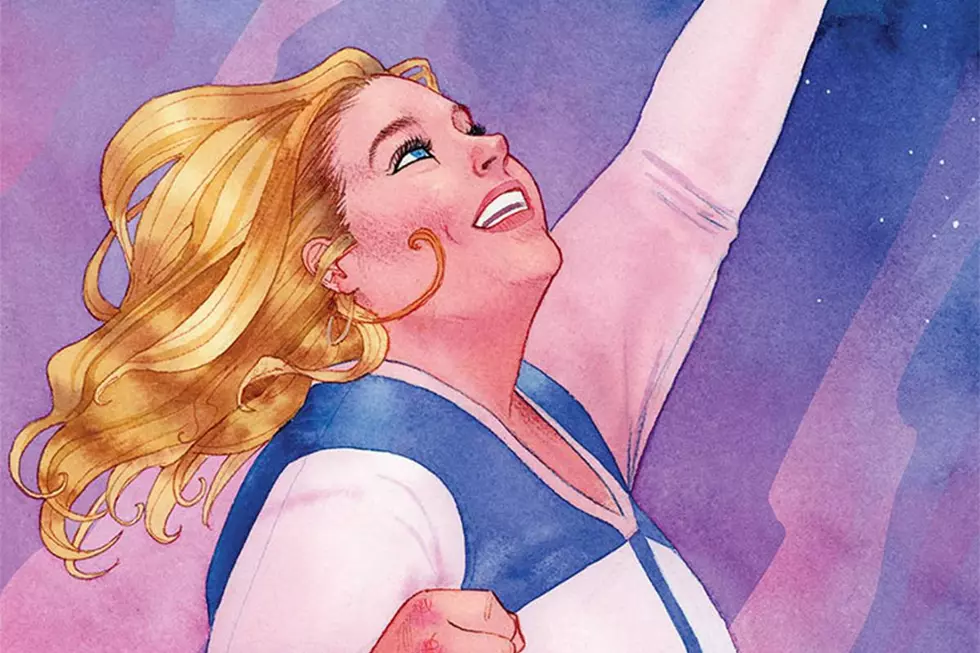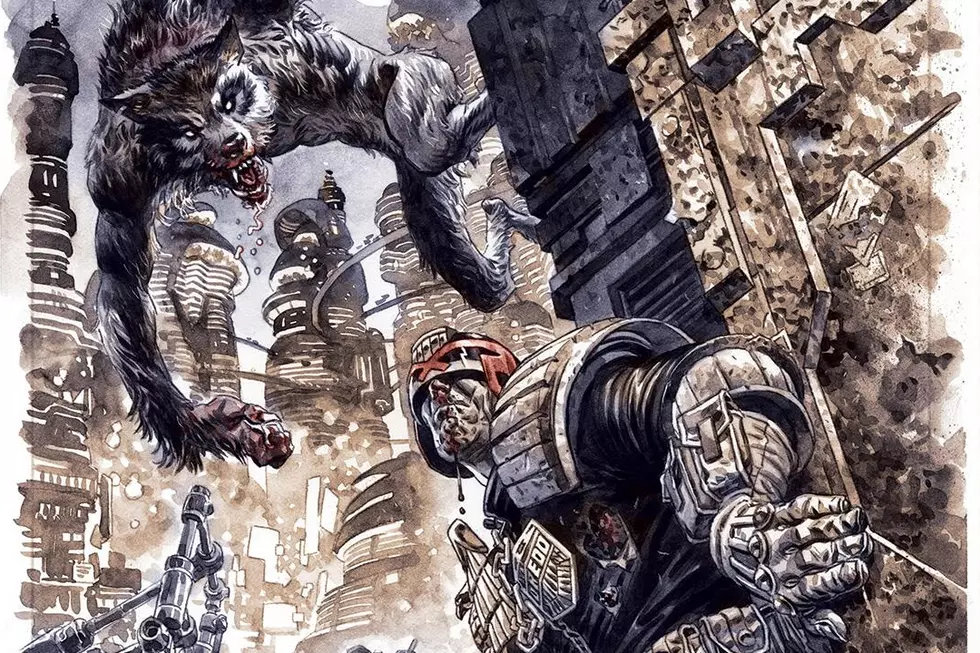
‘Dredd 3D’ Gives The ‘Judge Dredd’ Movie Franchise Some Much Needed Redemption

Despite the best efforts of friends and readers who have assured me that I'd like it, I'm about as unfamiliar with Judge Dredd as you can be while still reading comics all day for a living. I've only ever really read one Dredd story -- the pretty much mandatory battle against the Dark Judges where Dredd responds to "Gaze into the face of fear" with one of the most badass moments in comics history -- but I've never really gone much deeper.
Purely as an action movie fan, though, I've really been looking forward to Dredd 3D, the new adaptation from director Pete Travis starring Karl Urban as 2000 A.D.'s grumpiest lawman. And while I can't really speak from the perspective of a long-time Dredd fan, I thought the movie was great. As you might expect, Dredd does a lot to differentiate itself from the previous adaptation, 1995's Judge Dredd, starting right from the visuals. While the Stallone flick went all-out in trying to capture the visual style of the comics with dead accurate costumes and Lawmasters and ended up slapping them into a truly awful movie, Dredd goes in the opposite direction, scaling things down for a darker, grittier type of look. And yet, it's a change that really works well. Considering that Dredd actually is a cop (of a sort), dressing him like one makes sense on a visual level, and Jock's costume designs do a really nice job of translating the signature elements of his look to something that seems more functional. The giant gold epaulets and badges are a lot more subtle than they are in the source material, but they're still there as visual cues, and the virtually unchanged helmet holds Dredd's look together perfectly.
As you might expect, Dredd does a lot to differentiate itself from the previous adaptation, 1995's Judge Dredd, starting right from the visuals. While the Stallone flick went all-out in trying to capture the visual style of the comics with dead accurate costumes and Lawmasters and ended up slapping them into a truly awful movie, Dredd goes in the opposite direction, scaling things down for a darker, grittier type of look. And yet, it's a change that really works well. Considering that Dredd actually is a cop (of a sort), dressing him like one makes sense on a visual level, and Jock's costume designs do a really nice job of translating the signature elements of his look to something that seems more functional. The giant gold epaulets and badges are a lot more subtle than they are in the source material, but they're still there as visual cues, and the virtually unchanged helmet holds Dredd's look together perfectly.
I'm pretty sure anyone who cares about this would've already seen it by now, but if you haven't, rest assured: Karl Urban keeps the helmet on for the entire film.
Of course, while Dredd tries to get as far away as possible from its predecessor, there is one movie that it ends up getting a little too close to: The Raid: Redemption. The two movies have the same basic plot structure -- namely a small group of cops trapped against an entire building of bad guys ruled by a sinister crime lord -- and while it's easy to write that off as both films being direct descendants of Die Hard, there's one scene in particular where the bad guy gets on the PA that's virtually identical in both films. Even so, having just watched The Raid last week in anticipation of Dredd's release, I didn't think the two movies were actually all that similar.
What it comes down to is that they're trying different things in different ways. For The Raid, it's all about tight spaces and overwhelming odds, filtered through brutal, up-close combat. If The Raid has a theme, it's "stabbing," with the actual plot hung on as an afterthought to figuring out how to get shots of people hitting each other with fire axes and slicing their legs open with combat knives that look incredibly realistic without really killing anyone (I think). With Dredd, there's a completely different intent behind it. The claustrophobia isn't there -- the movie goes out of its way to establish the apartment block as a massive mile-high structure with plenty of open spaces -- and neither is the sense of panic. Dredd never seems like he's overwhelmed.
That's actually one of the really appealing things about Dredd. Even though I'm not that into the comics, I'm familiar enough with how they work to know that he isn't exactly a sympathetic character. He might be the guy that we root for because his enemies default to being pretty horrible people, but we don't identify with him. That's why the symbolism of never seeing him without his helmet is such an important part of the character. He's just a scowl and a uniform, remote, unknowable and unstoppable.
Those are the elements that Urban's performance and Alex Garland's script keep intact, even if they ditch the more satirical parts of the character in the process. Other than a bit at the beginning where Judge Anderson identifies his defining traits as anger and control -- which we probably could've figured out for ourselves -- we're never given insight into Dredd's mind or how he works. He stays remote through the whole thing, and for his part, Urban does a great job with it. He manages to come off as driven without being robotic, just quietly seething with rage at anyone who crosses him. When it finally comes time for him to drop his "I am the law" catchphrase, it's not the shouted histrionics of Stallone's version. It's quieter, broadcast to everyone in the movie in a moment that's almost sinister. There's a very slight amount done to soften his harshness that might defeat the point of a Dredd movie for hardcore fans -- he issues a warning to a homeless man rather than immediately busting him for vagrancy, but only because he has a triple homicide to deal with first -- but I really liked the way he was presented.
Because we can't identify with Dredd, we're given Judge Anderson, and again, Olivia Thirlby does a fantastic job with the material. She's a psychic rookie Judge who's being evaluated by Dredd as the last step in her training, and it's a dynamic that the movie has a lot of fun with. I mentioned before that Dredd never seems like he's not in control of the situation, and a lot of that comes from Urban calmly asking Thirlby what she thinks they should be doing in a given situation, continuing the evaluation throughout the entire movie even as they're assaulted by a dozen bad guys manning Gatling guns.

Anderson's psychic powers are also the source of most of the sci-fi in the movie, which manages to be distinctive without feeling overly gimmicky. It's set up as a fact of life early in the film and, along with the McGuffin drug that makes everything move in lurid, Speed Racer-esque glittery slow motion, provides virtually all of the scenes that make a decent enough use of the still-completely-unnecessary 3D.
It's a solid action movie, and it's worth noting that while films based on Marvel and DC characters often have their creators wedged in somewhere near the end of the credits, Dredd creators John Wagner and Carlos Ezquerra get their names on screen in giant red letters as the first thing you see when the movie ends. It's a pretty cool touch, and another thing to really like about the movie.
The only real problem -- aside from a slight plot hole that raises the question of why Ma-Ma, the main villain, thinks it'll be worse for her to have one of her henchmen interrogated than to kill two Judges, which the movie makes a half-hearted attempt at explaining -- is that it often just doesn't feel big enough. It's very clear that Travis and Garland weren't hedging their bets on getting to do a sequel and wanted to make a self-contained story, but the downside of that is that we only see a very small piece of this futuristic world that seems like it has a hell of a lot going on in it. It's not that anything in particular was left unfinished, but if this had been the two-hour pilot to an exceptionally well-produced Judge Dredd TV series, it would've worked fine in setting things up and introducing characters.
"I hope there's another one" isn't really a huge strike against it, though. It's a solid action movie that does a great job with a lean, brutal story. Maybe now I'll finally get around to reading those comics.
More From ComicsAlliance
![Judge Dredd Takes On Fairlyhyperman In ‘The Cape & Cowl Crimes’ [Preview]](http://townsquare.media/site/622/files/2017/03/Dredd00.jpg?w=980&q=75)
![The Law Returns To The Moon In ‘Judge Dredd Annual 2017′ [Preview]](http://townsquare.media/site/622/files/2017/02/Dredd00.jpg?w=980&q=75)



![The Best Dark Horse Comics Covers of 2016 [Gallery]](http://townsquare.media/site/622/files/2017/01/featured.png?w=980&q=75)



